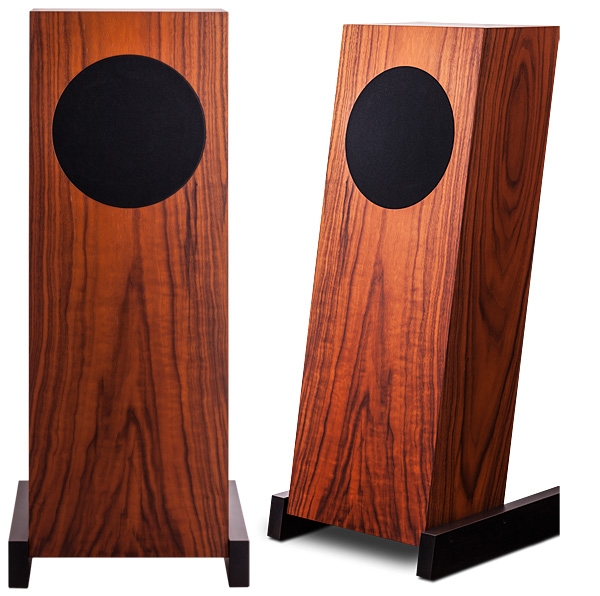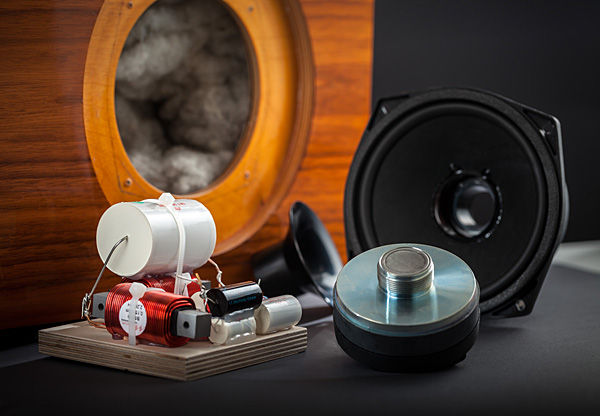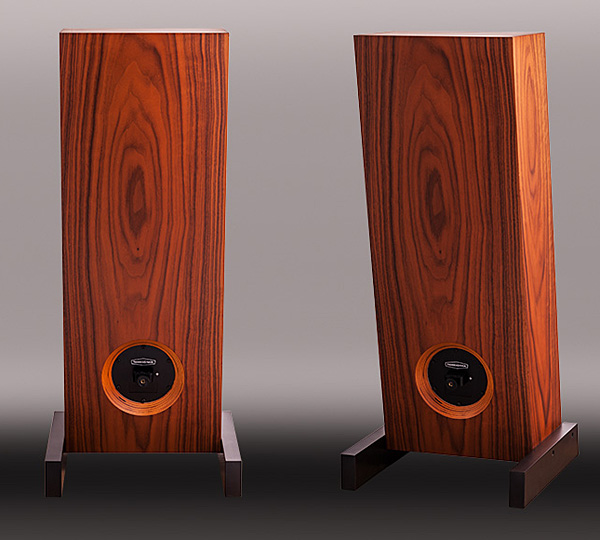| Columns Retired Columns & Blogs |
T&F Sun (Stereophile Class-A, limited LF) may be a better value for the money, at about less than half the price of Osiris :-) ..........

I first encountered T&F's approach when I reviewed the above-mentioned Sun, which proved to be the best small loudspeaker experience I've ever had. And I do mean small, as in 8.25" high by 6.25" wide by 5.5" deep and weighing a scant 7lb. The Sun did tone, soundstaging, image weight, and dynamics so well for its size that I felt compelled to review the No.3 speaker in Trenner & Friedl's lineup, the floorstanding Osiris ($8500/pair).
T&F likes to name its speakers after Egyptian deities, including Osiris but also Ra, Isis, and (generically, or maybe not—see below) Pharoah. As explained to me via email by Bob Clarke of Profundo, which distributes T&F products in the US, company co-founder and principal designer Andreas Friedl also identifies his speakers with jazz musicians—hence, "Pharoah" is also, very likely, a reference to Pharoah Sanders (note the spelling), "Ra" to Sun Ra.
Regardless, all Trenner & Friedl loudspeakers share such characteristics as cabinets built with multiple birch panels of varying thicknesses, multilayered lacquer finishes, oil-lacquered cones, crossovers built with Mundorf capacitors, locally sourced damping materials, and Cardas Audio cabling and binding posts.

Design
The Osiris's eye-catching 10-degree rearward slope gives it a windswept look recalling to my crusty memory the "blown away guy" from Maxell's print and television advertisements of the 1980s. The Osiris's proportions—it measures 33.5" high by 14.25" wide by 14.56" deep—reveal it for what it is: a small floorstander that should fit well in most living rooms.
On their website, T&F claims that proportions are determined by the Golden Ratio, that irrational number with mathematical, architectural, and mystical significance; designing a loudspeaker cabinet with "golden ratio" dimensions can avoid overlapping internal resonances. But when I asked Friedl how he arrived at the Osiris's particular dimensions, he responded with an email, writing, "the dimensions are chosen to fit perfect to the woofer [that the] Osiris should be a kind of egglaying, milkbearing woolly sow." To my immense relief, Clarke later explained that this is a German-based idiomatic expression for "something that can do many things, similar to jack-of-all-trades, Swiss Army knife, etc."
"The key to a cabinet design like this," Clarke elaborated, "is always going to be finding the correct size/shape and loading scheme, here, a hybrid horn-port, to support optimal bass performance of the particular woofer being implemented, as well as HF extension, to project an image and soundstage, even while placed near the wall." The Golden Ratio thing is just a guideline, not a hard-and-fast rule.
Clarke explained that the sloped-back design of the Osiris was partially a cosmetic choice to diversify T&F's heretofore boxy-looking loudspeaker line, but the design is also functional. "The more irregular internal shapes of the Osiris cabinet help to reduce internal standing waves," Clarke wrote in an email. "Also, sloped speaker fronts create shifting radiation angles of the drivers relative to the room and listener. If the radiation pattern is angled, it will help to reduce standing waves as the frequency moves upward and becomes more directional. It also puts the listener a bit off-axis in the tweeter radiation pattern, which tends to be less directional in this area, so there's less of a head-in-a-vise 'sweet spot.'"
Two black-painted wooden rails, each measuring 14.25" long by 1.125" wide by 3" high, attach to the bottom of the Osiris, forming its base. This creates a small (approximately 1") space between the floor and the bottom of the cabinet, which is entirely open, exposing a separate V-shaped wooden internal "port" attached within the lower portion of the cabinet. The "V-port"—my phrase—measures 6" wide at its base and 14" high, fanning out at the top of the V to cover almost the entire width of the cabinet.
"The port is a hybrid between a classic bass reflex design and a horn," Friedl explained. "We use the floor as part of the system, so the alignment is not so dependent on the room. It's a very efficient solution. But much smaller than a real horn construction."

Barely visible around the cabinet's port when viewing the speaker from below, an inner chamber behind the woofer is damped with a material that, according to Clarke, is made from a composite of recycled fibers and a long-staple local sheep's wool. Clarke added, "The horn/port construction constitutes its own considerable internal bracing, which also is internally angled to both create the horn/port and also to reduce any particular resonant frequencies, as the frequency of any resonance will change along the angled path of the brace-horn/port."
The Osiris's circular front grille can be removed by loosening two Allen screws on the rear of the cabinet, opposite the grille. Just as I was ready to do that myself, Clarke emailed photos of the 6.5" coaxial woofer/tweeter assembly, clearly showing its 1" compression tweeter, loaded by a hard plastic horn set within the woofer's paper cone; the horn protrudes approximately 0.25" and obscures much of the cone.
Manufactured by an unidentified pro-audio company, the Osiris's coaxial driver has a basket made of die-cast aluminum. The woofer cone is suspended via a rubber surround, and the driver has a 120mm ferrite magnet, while the compression tweeter is backed by a 110mm ferrite magnet. "Baked-in-lacquer, flat-copper Mundorf voice-coils" reportedly resist internal vibrations, Clarke wrote. The woofer's paper cone is coated with seven layers of Italian violin varnish to "optimize elasticity, damping and stiffness, and reduce cone resonances and distortion," Friedl said.
"Manufacturers have doped their paper cones with various materials, but none have used violin lacquer, which stiffens the cone overall, without making it completely rigid, which could introduce non-linearities. Many of the doped cones in the past were treated to simply damp nonlinearities (resonances), while [our] treatment makes the paper cone stiffer and improves bass without creating ringing problems in the upper frequencies."
Trenner & Friedl claims a nominal impedance of 8 ohms for the Osiris. "In the bass region," Clarke wrote, "where resonance points often bring about a big dip, the impedance never drops below 6 ohms. There is also a slight dip above 10–15k, due to a bypass in order to deliver superhigh frequencies unfiltered, which allows for an increase in precision and clarity. Between 20Hz–20kHz, impedance does not dip below 6 ohms."
Setup
The Osirises were the most finicky pair of loudspeakers to set up that I've ever reviewed. They required extensive break-in time to shed a dull sound and to gain warmth and extension in the bass. At first they sounded closed-in and listless. I played them 24/7 for two months via a $149 Sony STR-DH190 receiver transmitting Jersey City, New Jersey's excellent radio station WFMU.

T&F Sun (Stereophile Class-A, limited LF) may be a better value for the money, at about less than half the price of Osiris :-) ..........

... Klipsch La Scala II speakers. It's been over a decade since "Sam Tellig" sampled them. Perhaps KM can review current production units, or maybe the somewhat pricier latest AL5 iteration. His 20-30W tube amps should be a good match for them.

The Golden Ear Reference is in this range, as well.
It's a fascinating market point. This price is where speakers really seem to break loose of the main cost constraints and really start the party!
The T & F speakers are sure pretty, though!

I live in Austin (Round Rock is a suburb, and I recognized the road on which they're located so I googled it), and that address is a freakin' PostalAnnex+. They're not even a real company, just a box at a retail shipping service. They literally don't exist as a physical entity and their phone number (510 area code) is based in the Bay Area of California. Diety of your choice help you if you need US service for anything they distribute (like 5 obscure brands)....

Profundo will celebrate it's 20th anniversary next year. We moved to the Austin area 8 years ago from the SF Bay Area. Due to frequent travel and for continuity's sake, we have maintained our original phone number, which is mobile. Owing to the high value of the equipment we import and stock, we, like many distributors, maintain a mailing address that is separate from our physical location. We are not open to the public, as we sell through a dealer network.
I have to question the motivation for such a comment, other than just trolling. It does not address the product reviewed, its performance, or anything else relevant to the enjoyment of music, which is our primary goal in this industry. We support all our products, which rarely require service. The "youngest" product for us has been in our lineup since 2003, so these are not fly-by-night companies, rather, they are small, high-quality manufacturers that have very solid reputations worldwide, both for sound quality and reliability.
Since the author, "supamark" is a neighbor, perhaps he would like to meet for coffee sometime and learn more about our company and, also, maybe something about the products we import. We, and they, are quite real.

In my experience such a resonance as seen at 227 Hz is most often caused by an internal standing wave. Using 343/227/2 the internal dimension should be 0.76 m, which might very well match the internal height. It can be confirmed by measurements or by adding additional absorption in the bottom.

Aloha from Hawaii Audio! Just read this review and comments, and was saddened to see the comments about Profundo.
Bob Clarke is a CLASS ACT; I have communicated with him since at least 2005, when I was importing S.A.P. Audio of Salerno & exhibiting at CES. Always a big fan of VIVA Audio and also Transfiguration.
I bothered Bob on numerous occasions with inquiries; he was ALWAYS super responsive, courteous and professional.
Amazed and humbled that he is still running an audio import business in 2019. Hats off to him...and let's SUPPORT those who are still at it, instead of trying to tear them down...
Mahalo from Hawaii, for all your good will and professionalism all these many years, Bob!
Terry Hart
Hawaii Audio / S.A.P. Audio Int'l